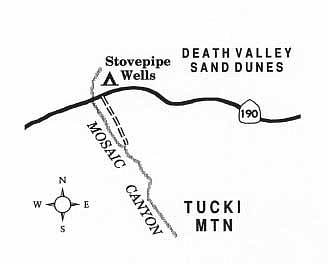 Facebook
Facebook
 X
X
 Instagram
Instagram
 TikTok
TikTok
 Youtube
Youtube
Death Valley's spaciousness is a big part of its appeal, but there's something here for claustrophobic individuals as well. In a few places, infrequent but powerful flash floods have carved narrow, sinuous channels into the bedrock of the mountains that border the valley. Mosaic Canyon is the most accessible of these deep, slot-like ravines.

The three-mile drive to the mouth of Mosaic Canyon, by way of a gravelly, unpaved road, starts just west of the village/campground of Stovepipe Wells. All but low-slung passenger vehicles can normally negotiate this road. As you rattle south, the sharply rising Tucki Mountains loom ever larger ahead. At road's end you set off on foot toward the nearby mouth of the canyon by following a normally dry, sandy wash. Only during rare periods of rainfall is the porous surface of the wash actually wet.
As you work your way up the increasingly narrow and deep ravine, notice the mosaic pattern of rocks embedded in the canyon walls. This type of rock, known as breccia (the Italian word meaning "fragments"), consists of jagged pieces of many kinds of rock incorporated into a matrix of marble.
Within a quarter mile, your passage through the ravine is highlighted by the sight of polished marble walls ascending nearly vertically. High above you, in a few spots, you might see bits and pieces of trees and shrubs left by the cresting waters of some past flash flood. Flooding has certainly done the carving, but the direction in which those waters traveled was controlled to a large extent by preexisting rifts, or faults, in the mountain slope.
Your hike into Mosaic Canyon can take as little as 20 minutes -- or as much as a couple of hours or more if you're willing to use your hands as well as your feet to climb over several "dry falls," or steeply inclined chutes, worn into the bottom of the canyon. Take along plenty of water if you intend to spend a lot of time in the upper canyon.

Death Valley's spaciousness is a big part of its appeal, but there's something here for claustrophobic individuals as well. In a few places, infrequent but powerful flash floods have carved narrow, sinuous channels into the bedrock of the mountains that border the valley. Mosaic Canyon is the most accessible of these deep, slot-like ravines.

The three-mile drive to the mouth of Mosaic Canyon, by way of a gravelly, unpaved road, starts just west of the village/campground of Stovepipe Wells. All but low-slung passenger vehicles can normally negotiate this road. As you rattle south, the sharply rising Tucki Mountains loom ever larger ahead. At road's end you set off on foot toward the nearby mouth of the canyon by following a normally dry, sandy wash. Only during rare periods of rainfall is the porous surface of the wash actually wet.
As you work your way up the increasingly narrow and deep ravine, notice the mosaic pattern of rocks embedded in the canyon walls. This type of rock, known as breccia (the Italian word meaning "fragments"), consists of jagged pieces of many kinds of rock incorporated into a matrix of marble.
Within a quarter mile, your passage through the ravine is highlighted by the sight of polished marble walls ascending nearly vertically. High above you, in a few spots, you might see bits and pieces of trees and shrubs left by the cresting waters of some past flash flood. Flooding has certainly done the carving, but the direction in which those waters traveled was controlled to a large extent by preexisting rifts, or faults, in the mountain slope.
Your hike into Mosaic Canyon can take as little as 20 minutes -- or as much as a couple of hours or more if you're willing to use your hands as well as your feet to climb over several "dry falls," or steeply inclined chutes, worn into the bottom of the canyon. Take along plenty of water if you intend to spend a lot of time in the upper canyon.
Comments